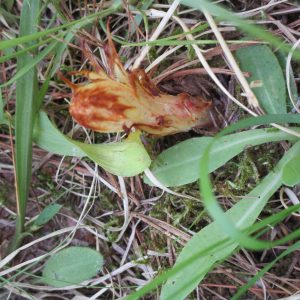There is no standard day here at the Uncompahgre field office. One day, you are driving in a UTV to the edge of the wilderness and the next you are struggling to create a shapefile in an air-conditioned office. In my first months at the BLM, I have been immersed in the Assessment, Inventory and Monitoring Program or AIM. Most of the time, we drive our Dodge Ram over bumpy, rock riddled dirt roads to a randomly chosen site in the Adobe Badlands of North Delta. In the first week, when I was introduced to the 40,000 acres where our 60 plots were randomly strewn- I had some trepidations. The area looked barren and over run by the last years growth of Galleta grass and some of the hills appeared to be man made deposits, they were so bare and perfectly rounded.
But on a closer look there is something to see: bits of fossilized shells from the time that this area was an inland sea, shadscale, Spanish Bayonet, charming woody aster and -if you’re there at the right time- blooming prickly pear and strawberry hedgehog cacti. Occasionally, the hills move as reintroduced Pronghorns run over them and spooked prairie dogs scurry into their holes. All it took to begin to see the life in this area, was spending time trekking over its clay soils and through the dried up riverbeds, all the while stopping to examine the difference between the grasses.
Being in the desert has taught me to consider the details and then, the implications therein. It took paying attention to something as small as the pebbles covering the ground. . What does the overabundance of snakeweed indicate? Why is this Wyoming Sage thriving here and nowhere else? Did you notice the suddenly round, riverine stones?
It is easier to love something that is large and colorful- charismatic fauna that is immediately visible and awe-inspiring in its presence like a towering redwood or the snow capped peaks of the San Juan Mountains. It is harder to love a bare soil dominated by drought stressed plants with their subdued colors, stunted growth and struggling small flowers. Everyday in the field, we must look for the story in the landscape and, honestly, I have cheered when I saw a thriving shrub. The evolving relationship I have with the landscape as my knowledge of its ecology deepens is one of my favorite things about this position thus far.
We have just completed our 46th plot out of 60 and we will be taking a break because of the heat. I am surprised that I will miss the dry land of North Delta. Thanks for teaching me patience, honing my eye for detail and showing me- so clearly- the power of learning to appreciate an area of land based on the delicate balance of its ecology rather than the colors of its flowers.
Uncompahgre Field Office
Bureau of Land Management




















